I want to take a look at a game that has about eight levels. You get new weapons from the bosses you beat. Each of these weapons is useful against a specific boss, and is also useful in getting through each area as well. You have two bars, too. One for weapons, one for your life. You’re also blue.
Do you know what game it is?
…
Psychic World, of course!
Did you think I was talking about something else?

Or Psycho World, if you prefer.
Psychic World comes in three distinct flavors, and I want to touch on each one of those. It was developed by a now defunct company named Hertz and it originally appeared on the MSX computer system in 1988 as Psycho World, but was later reworked for the SEGA Master System and the Game Gear in 1991, the latter probably being the most well known. SEGA did the port over and they made the decision to change the title from “Psycho” to “Psychic”. We’re all better off for it, honestly. Quite frequently the game was written off as a Mega Man clone, but I always felt it was worth a bit more than that and was a pretty solid game in it’s own right. The similarities really stop at everything I pointed out above and if we analyze every game that we comes across like that, pretty much everything seems derivative of something else.
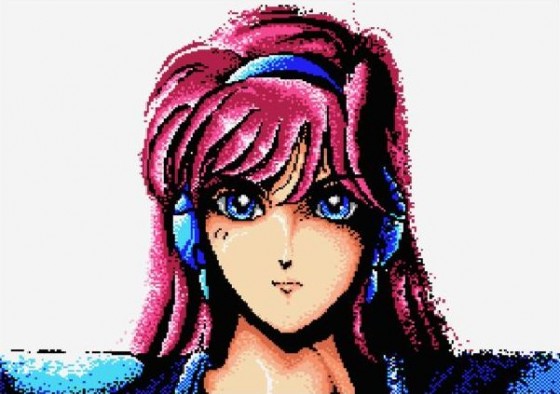
Lucia, ready to battle baddies…with mind bullets!
The premise to Psychic World is fairly simple. You’re Lucia and you’re researching ESP in a “science lab” in “the middle of nowhere” with your twin sister Cecile and Dr. Knavik. Surely nothing could go wrong here? There’s an explosion and monsters kidnap your sister Cecile. Now it’s up to you to go after those monsters and get your sister back with the aid of an ESP booster from Dr. Knavik. I couldn’t come up with a better storyline that captures the sheer zaniness games of this era can have. It’s so corny that it’s awesome. There’s a cutscene at the beginning that explains all of this to you as well, in all of it’s early 90′s badly translated glory. But again, I find a certain charm in that.
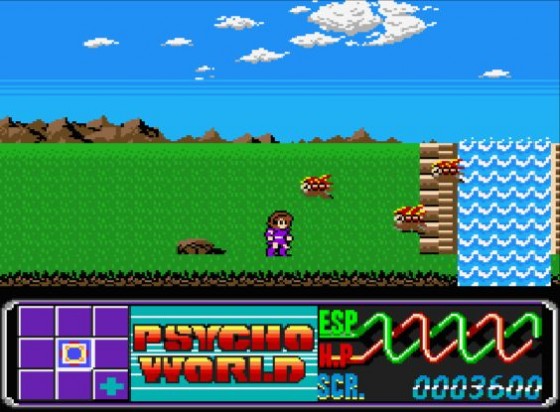
I was never sure what some of these enemies were supposed to be.
All three versions play the same, mostly. You venture through a series of stages collecting new weapons, abilities, and power ups along the way. For the most part you get a new weapon from the stage bosses. You start with your basic wave shot, then gain water, fire, ice, and sonic shots. All of these can be powered up several times by getting the item same icon again. You can switch through these weapons freely. Certain ones are more effective on certain enemies, and you need to use some of them to navigate through each stage. For example, in the ice field, you use the water shot to make blocks to stand on and use the fire shot to melt them. In the ruins field, you use the sonic shot to erode blocks in your path. Most of the larger enemies and bosses are weak against a specific weapon and it’s mostly trial and error to figure out which one’s going to work the best.
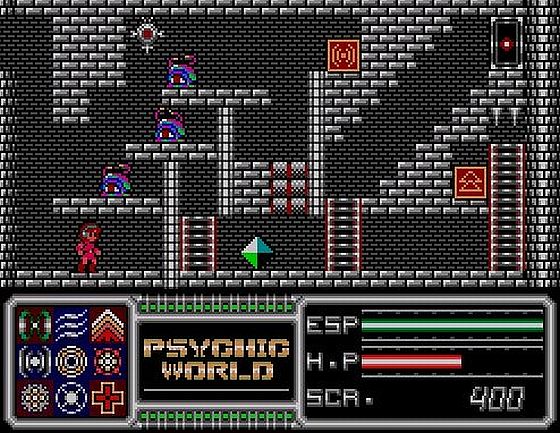
I’m not sure why some levels had to be so cramped on Master System.
There’s some abilities you gain as well. You’ll learn an explosion that damages mostly everything on the screen. It can be pretty useful, but it takes a good chunk of your ESP bar. You also gain a levitation ability, which is great for getting yourself into those hard to reach places or simply avoiding spikes and other dangers. There’s the healing ability, which grants you temporary invincibility and also lets you heal if you use it multiple times in a row before the invincibility runs out. Again, this uses a fair chunk of your ESP, but there’s bonuses laying all over that will refill your bar. Finally, there’s an ability that lets you return to the start of the stage, which I never found particularly useful.

The Game Gear tries to represent the Forest stage at the beginning of the Ruins.
The three versions don’t really deviate from each other in terms of basic gameplay. The biggest difference is how the Game Gear and Master System versions handle running. In the original MSX version, you do a double tap left or right. It’s a bit tricky to pull off. In the ports you build up speed as you move forward. Additionally, the Game Gear version pauses the action when you select a different weapon or power up which makes the game a bit easier than the other two.
The biggest difference of all is the stages themselves. The layouts are entirely different, making each version a unique experience, however the Master System cuts out three stages from the MSX version, and the Game Gear version cuts out four. I felt the Game Gear version did a better job at representing each stage from the original version, even if there are only half of them, where as the Master System version sort of does it’s own thing towards the end.

Powered up and ready to trek through the final area.
In terms of challenge, no particular version is that hard. The MSX version has a nice save feature, so you can blunt force your way through each of the levels. I felt the Master System version, while shorter, was a bit more frustrating due to a lot of areas that felt cramped or were just plain mean. About ⅓ of the final stage is levitating through spikes and if you run out of ESP or don’t time it right, you’re greeted with a game over. The easiest version is certainly the Game Gear version mostly due to the above mentioned pauses in the action, and the fact that it’s a bit shorter. As it should be, after all, it is the portable version on a system that ate 6 AA batteries in about an hour.
Graphically, the MSX version does well for what they had to work with. The MSX had trouble with scrolling graphics, and they did a good job handling that. For Master System they mimicked the graphic style of the MSX version quite well, but it looks very dated for a game from 1991 and a lot of the color choices they made don’t work quite right. For some reason they changed Lucia’s sprite to red instead of the violet that she is in the other versions. It sounds nit-picky, but she ends up blending into the backgrounds, and so do a lot of the enemies for that matter. I’m not sure why they felt the need to make the change. The Game Gear version was given a graphic overhaul mostly to accommodate for the Game Gear’s smaller screen. The color choices are much better, and everything looks very crisp.
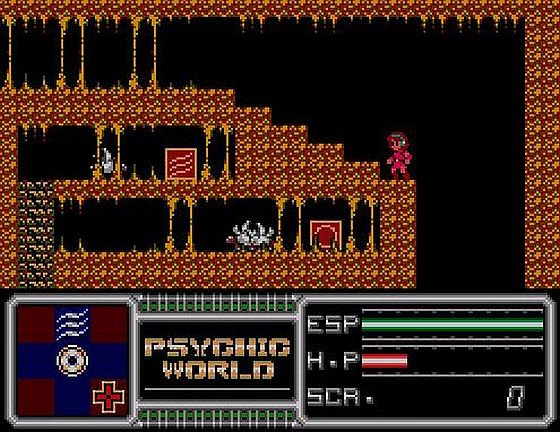
The black backgrounds tend make the Master System version look older than it is.
The music is all very good with nice upbeat feel to it. Obviously the MSX version has more music, but the best tracks were taken and used in the other versions. The “Prairie” theme is probably the most iconic. It all fits the game well, and the only theme I didn’t really like was from the “Ruins” in the MSX version which had kind of an Aztec sounding melody to it which didn’t really fit the pacing of the game. In the other versions were were given the music from the “Forest” area in it’s place. Thumbs up for that.
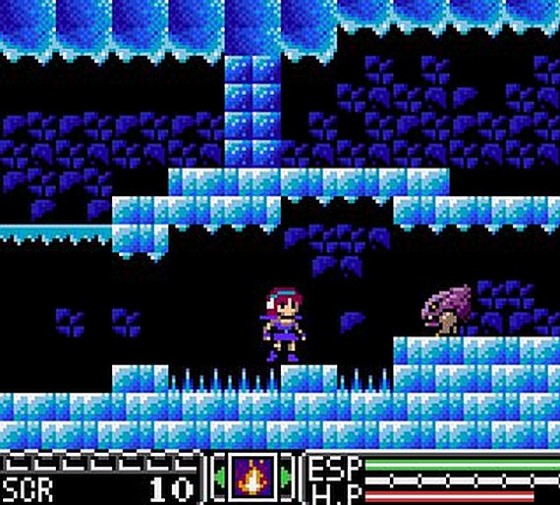
Fire’s useful in the ice stage? Go figure.
Even though Psychic World isn’t available as a digital download on any of the current gen systems, it’s fairly easy to obtain. While the Master System version was only released in Europe, I can tell you with personal experience it works just fine on a US system. The Game Gear version is fairly easy to track down as well in all regions. I’d suggest the Game Gear version over the Master System, simply because it just felt a bit more solid even if it’s a bit shorter and easier. While both versions are good, the MSX version reigns supreme, offering a much fuller experience. Unfortunately, I’ve never seen a legitimate copy of it for sale. If you’ve played any version, it’s worth checking out the others to get a slightly different take on the same game. Psychic World, in any of it’s incarnations, is a blast to play and a fun way to kill an hour.
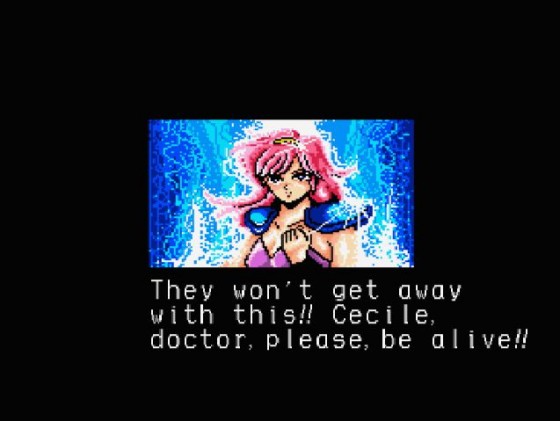
There’s a lot of cool artwork like this only seen in the MSX version.
On a personal note, Psychic World was one of the first Game Gear games I played, and when I was a kid I was absolutely enamored by it. It was always one of those games that was in the back of my mind that I thought “you know, I’d love to see more of that”. Once I found out there were other versions, I instantly started tracking them down. While the storyline was kind of cheesy, it was really fun. It inspired my imagination to about the same extent as The Legend of Zelda: A Link to the Past which I played around the same time. The ending vaguely hints at a sequel, but it never happened. It’s one of those games where if I could buy the rights myself, I’d make a Kickstarter to fund a sequel. In a heartbeat. Hertz didn’t go on to make a whole lot afterward, but what they did work on was pretty awesome. Most notably is the Sega CD, and now iPhone classic, Vay which I’d love to touch on in the future.
Play it? Love it? Hate it? Want to throw a boot at my head? I want to know what you think! Comment below or send me something on twitter!


